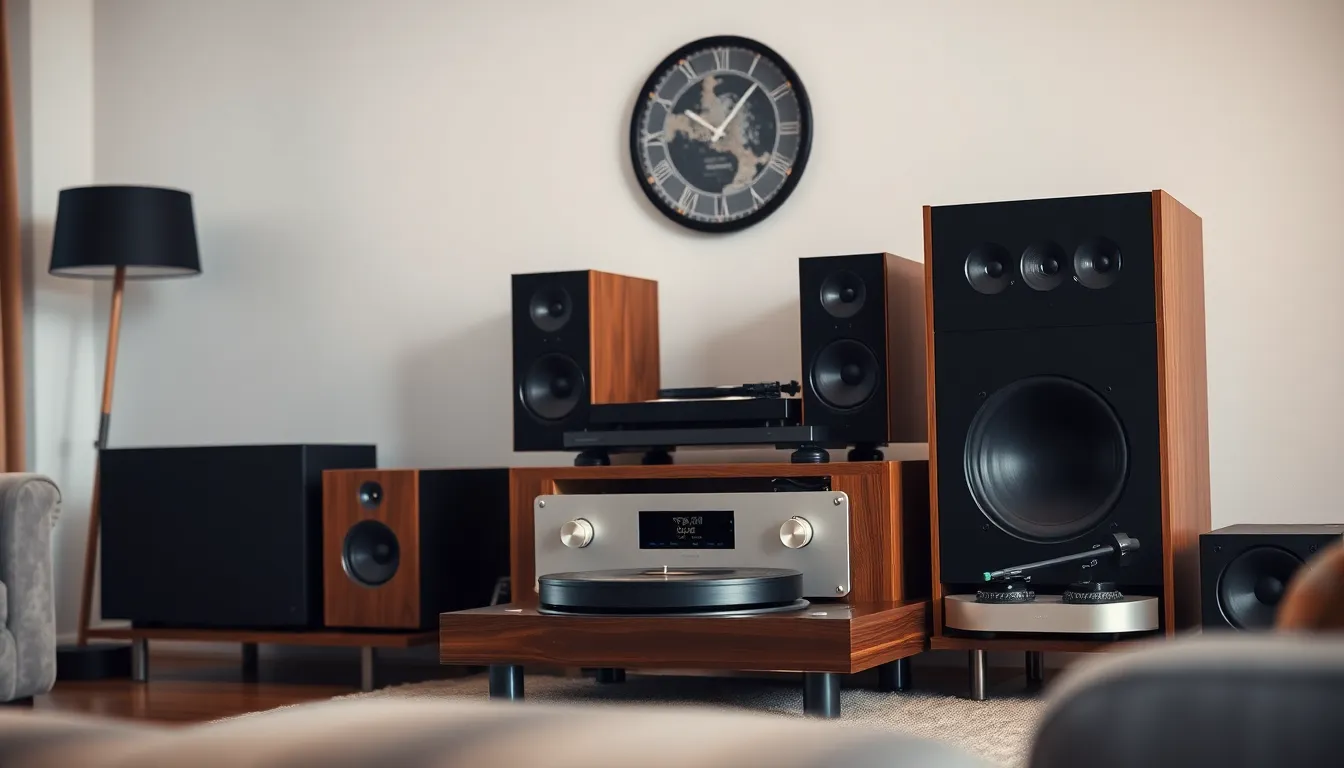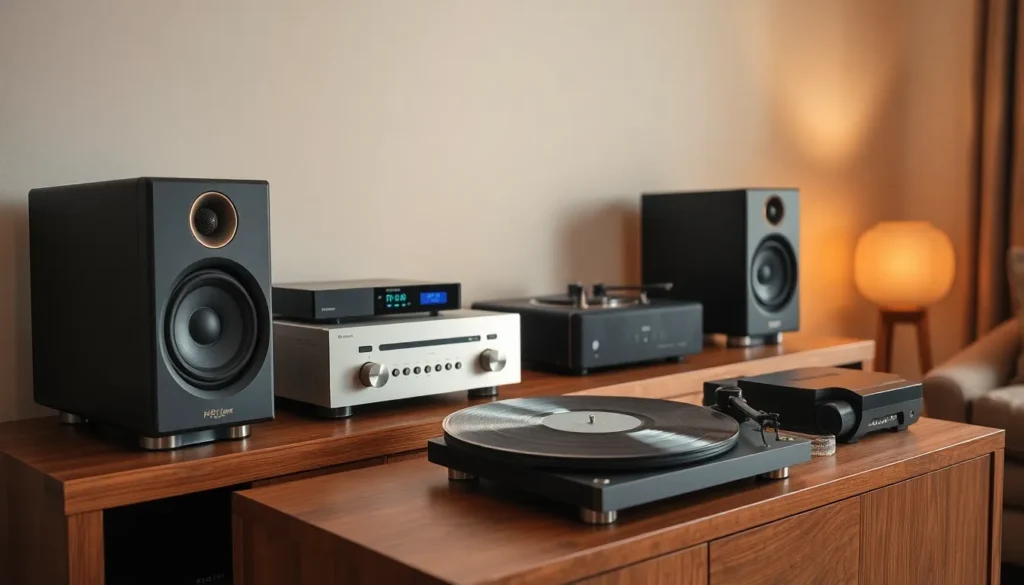Imagine sinking into your favorite chair, the lights dimmed just right, and the sweet sound of music wrapping around you like a warm hug. That’s the magic of Hi-Fi systems. They’re not just fancy speakers; they’re gateways to an audio experience that makes even the most mundane Tuesday feel like a concert night.
Table of Contents
ToggleOverview of Hifi Systems
Hi-Fi systems enhance audio playback, offering superior sound quality compared to standard equipment. These setups consist of various components, including amplifiers, speakers, and digital-to-analog converters (DACs).
Amplifiers boost audio signals, crucial for driving speakers effectively. Quality speakers reproduce sound accurately, allowing for a richer listening experience. DACs convert digital signals into analog formats, making sound retrieval sharp and vibrant.
Many enthusiasts favor the aesthetic and functional versatility of Hi-Fi systems. Configurations vary based on user preferences, accommodating everything from small listening spaces to dedicated home theaters. Component selection reflects an individual’s taste, balancing brands and styles for optimal performance.
Listening to music through Hi-Fi systems creates a sense of presence, bringing the listener closer to the original recording. Certain units include features like wireless connectivity, enabling streaming from various devices seamlessly. Consumers today often consider integration with smart technology, ensuring compatibility with wider systems.
Hi-Fi systems cater to different genres and preferences, resonating well with audiophiles. Certain setups excel in reproducing classical music’s depth, while others might shine with bass-heavy genres like electronic or hip-hop. The choice of components significantly impacts overall sound quality, making information on specifications crucial.
Specifications such as frequency response, total harmonic distortion (THD), and power output should guide purchasing decisions. Evaluating these metrics provides insight into the performance capabilities of Hi-Fi systems, enabling informed choices. Every detail contributes to overall satisfaction, solidifying the value of investing in quality audio equipment.
Key Components of Hifi Systems

Hi-Fi systems consist of several key components that work together to deliver exceptional audio experiences. Understanding these elements enhances the selection process for an optimized listening environment.
Amplifiers
Amplifiers play a crucial role in Hi-Fi systems, boosting audio signals for better sound quality. They take weak input signals from sources like turntables or digital players and amplify them to drive speakers. Various types of amplifiers exist, including tube, solid-state, and integrated options. Tubes offer a warm, rich sound, while solid-state amplifiers deliver clarity and precision. Integrated amplifiers combine the functions of a preamplifier and a power amplifier into one unit, simplifying setups.
Speakers
Speakers are essential for accurate sound reproduction in Hi-Fi systems. Different types include bookshelf, floor-standing, and subwoofers, each catering to unique listening environments. Bookshelf speakers work well in smaller spaces, while floor-standing units produce deeper bass and fill larger rooms. Multi-driver designs enhance soundstage and frequency response, ensuring a detailed audio experience. Selecting quality speakers aligns closely with personal listening preferences and can significantly affect enjoyment.
Sources
Sources refer to devices that provide audio signals to Hi-Fi systems. Common examples include CD players, turntables, smartphones, and streaming devices. Each source type has its distinct characteristics that contribute to the overall sound quality. For example, vinyl records deliver warmth with analog charm, while high-resolution audio files provide crystal-clear details. The choice of source impacts the sonic signature and overall listening experience, making it vital to consider compatibility with other components.
Types of Hifi Systems
Hi-Fi systems come in various forms, each tailored to unique listening environments and user preferences. Understanding these types enables informed purchasing decisions.
Stereo Systems
Stereo systems offer a classic audio experience with two-channel sound. These systems typically include an amplifier and two speakers, providing balanced sound for music enthusiasts. Integrated amplifiers combine both functions, simplifying setup. Components often include CD players or turntables, allowing versatile playback options. The quality of speakers plays a critical role, as bookshelf models deliver detailed audio in smaller spaces, while floor-standing options fill larger rooms with sound. For those who enjoy vinyl, adding a turntable enhances the listening experience further.
Home Theater Systems
Home theater systems create an immersive cinematic experience at home. Surround sound setups typically consist of multiple speakers positioned around the room, enveloping listeners in audio. Components include a receiver, subwoofer, and various speakers, allowing for tailored audio performance. Popular configurations range from 5.1 to 7.1 channels, where additional speakers enhance spatial awareness. High-definition video playback typically accompanies these systems, providing full audiovisual enjoyment. Integrated smart technology often allows for seamless streaming and connectivity with other devices, catering to modern entertainment needs.
Factors to Consider When Choosing Hifi Systems
Selecting a Hi-Fi system requires careful consideration of various factors. These elements can significantly influence the overall sound experience and satisfaction.
Budget
Budget remains a critical factor when choosing a Hi-Fi system. Systems vary widely in price, ranging from affordable entry-level options to high-end professional setups. Establishing a budget aids in narrowing down choices efficiently. Audiophiles can find good quality systems between $500 and $2,000, which often includes essential components like amplifiers and speakers. Higher-priced systems typically offer advanced features such as superior materials and enhanced sound clarity. Allocating a distinct portion of funds for accessories like cables and stands helps in optimizing the audio setup.
Space Requirements
Space requirements play a vital role in Hi-Fi system selection. The size of the listening area influences which components will fit and perform best. Small spaces may benefit from compact speakers and integrated amplifiers, whereas larger rooms can accommodate floor-standing speakers and multi-channel systems. Evaluating available floor space ensures speakers do not overwhelm the room or produce distorted sound due to proximity to walls. Acoustic treatment options also add value, enhancing the overall listening experience. Maximizing space involves considering setups that suit specific listening habits, such as casual listening or dedicated music sessions.
Compatibility
Compatibility affects how well different components interact within a Hi-Fi system. Ensuring that amplifiers match speaker specifications is essential for achieving optimal sound quality. Component connectivity becomes crucial too, with digital inputs required for modern streaming devices and analog connections needed for traditional sources. Checking whether devices support wireless technology adds flexibility to the system. Compatibility with home automation systems can enhance user experience, allowing for seamless control through smart devices. Prioritizing compatible equipment minimizes integration issues and enhances the overall listening experience.
Hi-Fi systems offer a transformative audio experience that elevates music enjoyment to new heights. The careful selection of components like amplifiers, speakers, and DACs plays a crucial role in delivering superior sound quality. Whether one prefers the simplicity of a stereo system or the immersive nature of a home theater setup, there’s a Hi-Fi solution to suit every listener’s needs.
Investing in a quality Hi-Fi system not only enhances everyday moments but also brings a sense of connection to the music. With various options available, from compact setups to elaborate configurations, anyone can find the perfect match for their space and preferences. The journey into high-fidelity sound is not just about listening; it’s about experiencing music in its most authentic form.








